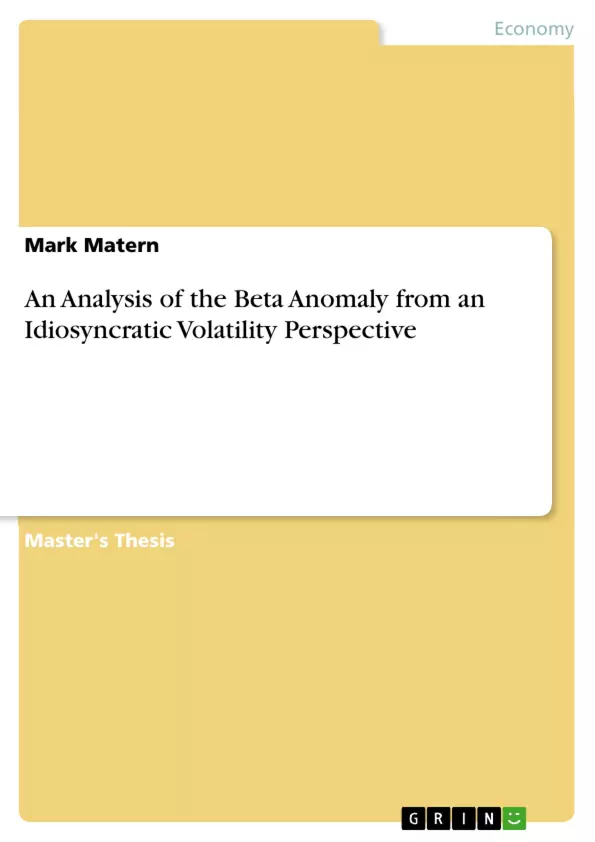The foundation of this contribution will be the verification of the empirical results presented by Liu et al. (2017). We will start by summarizing their findings and explanations in Chapter 2 (Theoretical Background) and build the theoretical foundation upon which the empirical interpretation will rest. We actually view the compilation of the theoretical explanations in an intuitive line of reasoning as our first valuable contribution for our readers, as an understanding of the topic is not as easily to grasp after a first consultation of the papers. In Chapter 3 (Empirical Results) we address the actual calculations and most important summary statistics that will either speak in support or against our interpretations. In 3.1 (Data and Methodology), we present our dataset important technical notes and in Chapter 3.2 (The Beta Anomaly) we summarize and try to replicate the empirical findings of Liu et al. (2017), which will serve as the bedrock of interpretations we will arrive at in following pages. In Chapter 3.3 (Betting-against-Correlation) and its sub-sections on leverage, size and sentiment, we turn our attention to a paper by Asness et al. (2017) which contributed and responded to the findings of Liu et al. (2017), but with often diametrically contradicting views. The reference date of 2017 suggests that both papers belong to a highly new set of research and we believe that by covering those two and adding our own findings we can add significant clarity to actually understand what is going in the space of the beta anomaly. In Chapter 3.4 (BAB vs. BAI), we finalise the empirical analysis by contrasting opposing views on strategies that are designed to exploit the low-beta anomaly and realign the findings that we came across. We will summarize the newly gained insights for our readers in our last Chapter 4.
Inhaltsverzeichnis (Table of Contents)
- Introduction
- Theoretical Background
- Empirical Results
- Data and Methodology
- The Beta Anomaly
- Betting-Against-Correlation
- BAC Leverage Effects
- BAC and Size Effects
- BAC and Sentiment Effects
- BAB versus BAI
- Conclusions
Zielsetzung und Themenschwerpunkte (Objectives and Key Themes)
This master thesis investigates the phenomenon of idiosyncratic volatility (IVOL) and its relationship to the beta anomaly. It analyzes the potential for generating alpha through strategies that exploit the negative correlation between IVOL and stock returns.
- Investigate the relationship between IVOL and the beta anomaly
- Analyze the profitability of betting-against-correlation (BAC) strategies
- Explore the impact of leverage, size, and sentiment on BAC performance
- Compare the effectiveness of BAC strategies to traditional beta-anomaly (BAB) strategies and other IVOL-based strategies (BAI)
- Contribute to the understanding of market inefficiencies and alpha generation opportunities
Zusammenfassung der Kapitel (Chapter Summaries)
The thesis begins by providing a theoretical background on IVOL and the beta anomaly. It discusses the theoretical foundations and empirical findings related to these concepts. Chapter 3 delves into the empirical results of the research, starting with a description of the data and methodology used. The chapter then investigates the beta anomaly and analyzes the profitability of BAC strategies, considering leverage, size, and sentiment effects. It further compares the performance of BAC, BAB, and BAI strategies. The thesis concludes by summarizing the findings and discussing their implications for market participants and further research.
Schlüsselwörter (Keywords)
Idiosyncratic volatility, beta anomaly, betting-against-correlation, leverage effects, size effects, sentiment effects, alpha generation, market inefficiencies, empirical analysis, portfolio strategies.
- Quote paper
- Mark Matern (Author), 2017, An Analysis of the Beta Anomaly from an Idiosyncratic Volatility Perspective, Munich, GRIN Verlag, https://www.grin.com/document/413290



